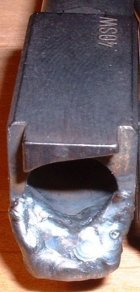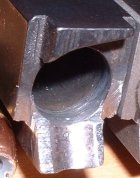I've been nosing around this forum for a little while, soaking up info on rifle shooting. Seems like a nice place. I've been a pistol shooter for quite a while - maybe I can share some experience here...
Unfortunately, this actually does sound quite a bit more like a pressure issue rather than a simple cracked slide. .45 ACP is an extremely low pressure cartridge, and a slide failure in the area you describe is not going to result in the catastrophic failure you experienced. I've seen .45s run for years and thousands of rounds with cracked slides, depending on the crack - even in relatively high stress areas like breechfaces.
What you're describing is the result of a very high pressure situation - the base of the case blows out where its unsupported at the bottom, typically blowing off the base pad of the magazine and shooting the contents of the mag out the bottom,ammo, mag spring, follower, etc), cracking or blowing out grips, breaking trigger parts, possibly breaking sear/hammer/disconnector, etc. If pressure is high enough, it can blow out the barrel hood, as well, and do all sorts of other bad things. High pressure situations also cause other problems - and one of those is exceeding the strength of various parts, notably slides. I suspect the crack in your slide resulted from the high pressure round.
You most definitely can blow a gun up with .45 ammo. Even with factory ammo. .45 is generally loaded with fast to medium-fast pistol powder, and the case is capable of taking a double or even triple charge of powder. With faster powders, a triple charge won't even be compressed!
Another issue that has come to light is that a lot of factory ammo is vulnerable to bullet setback - especially with factory weight or heavier recoil springs,16# is standard in a 1911 for most factories). This becomes especially visible if you've loaded a particular round more than once,say, you shoot a string, unload the gun, and take the round that was in the chamber and put it back in the magazine, and load it again). I've noticed this visibly, myself, with factory .40 S&W ammo. Several police departments have recently blown up Glock 21 pistols,in .45 ACP) due to this issue, as well. Bullet setback rapidly ramps up the pressure in these pistol cartridges - a tenth of an image can be very very bad.
Obviously, reloaders need to be diligent when reloading this cartridge!
That said... S&W's response is a bit odd. This is not a common situation. "Impossible" to have a crack is wrong - in fact, its far more likely to have failed castings with voids or cracks than forged or barstock parts, so... You're definitely receiving a "lawyer response" from them, and that stinks. But, I don't think this is their fault from your description - unfortunately, I do think it was your ammo. Who made *that*??
I've seen all kinds of defects with factory ammunition, BTW. Cases too long, so they won't chamber. Powder missing. No bullet pull,setback!). No flash hole. Defective powder or primer. You name it...
There's a lot of info on this forum, and in the various loading manuals about monitoring rifle rounds for pressure problems. If you pay attention - and are careful with your reloading - you shouldn't even experience the detonation type of problem you had with your .45 in a rifle. The pressure changes should be more gradual than that...
BTW - I'm extremely glad you're OK! How'd you get stuff in your eyes? Did it make it around your glasses?












